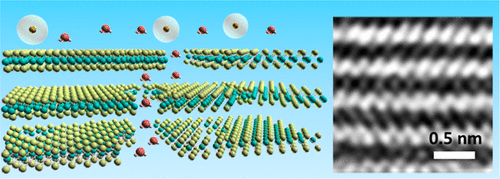当前位置:
X-MOL 学术
›
Nano Lett.
›
论文详情
Our official English website, www.x-mol.net, welcomes your
feedback! (Note: you will need to create a separate account there.)
Experimental Realization of Few Layer Two-Dimensional MoS2 Membranes of Near Atomic Thickness for High Efficiency Water Desalination
Nano Letters ( IF 9.6 ) Pub Date : 2019-07-01 00:00:00 , DOI: 10.1021/acs.nanolett.9b01577 Hao Li 1, 2 , Tae-Jun Ko 1 , Myeongsang Lee 1 , Hee-Suk Chung 3 , Sang Sub Han 1, 4 , Kyu Hwan Oh 4 , Anwar Sadmani 5 , Hyeran Kang 1, 6 , Yeonwoong Jung 1, 2, 7
Nano Letters ( IF 9.6 ) Pub Date : 2019-07-01 00:00:00 , DOI: 10.1021/acs.nanolett.9b01577 Hao Li 1, 2 , Tae-Jun Ko 1 , Myeongsang Lee 1 , Hee-Suk Chung 3 , Sang Sub Han 1, 4 , Kyu Hwan Oh 4 , Anwar Sadmani 5 , Hyeran Kang 1, 6 , Yeonwoong Jung 1, 2, 7
Affiliation

|
A globally imminent shortage of freshwater has been demanding viable strategies for improving desalination efficiencies with the adoption of cost- and energy-efficient membrane materials. The recently explored 2D transition metal dichalcogenides (2D TMDs) of near atomic thickness have been envisioned to offer notable advantages as high-efficiency membranes owing to their structural uniqueness; that is, extremely small thickness and intrinsic atomic porosity. Despite theoretically projected advantages, experimental realization of near atom-thickness 2D TMD-based membranes and their desalination efficiency assessments have remained largely unexplored mainly due to the technical difficulty associated with their seamless large-scale integration. Herein, we report the experimental demonstration of high-efficiency water desalination membranes based on few-layer 2D molybdenum disulfide (MoS2) of only ∼7 nm thickness. Chemical vapor deposition (CVD)-grown centimeter-scale 2D MoS2 layers were integrated onto porous polymeric supports with well-preserved structural integrity enabled by a water-assisted 2D layer transfer method. These 2D MoS2 membranes of near atomic thickness exhibit an excellent combination of high water permeability (>322 L m–2 h–1 bar–1) and high ionic sieving capability (>99%) for various seawater salts including Na+, K+, Ca2+, and Mg2+ with a range of concentrations. Moreover, they present near 100% salt ion rejection rates for actual seawater obtained from the Atlantic coast, significantly outperforming the previously developed 2D MoS2 layer membranes of micrometer thickness as well as conventional reverse osmosis (RO) membranes. Underlying principles behind such remarkably excellent desalination performances are attributed to the intrinsic atomic vacancies inherent to the CVD-grown 2D MoS2 layers as verified by aberration-corrected electron microscopy characterization.
中文翻译:

几层接近原子厚度的二维MoS 2膜用于高效海水淡化的实验实现
全球迫在眉睫的淡水短缺一直要求采取可行的策略,以通过采用经济高效的膜材料来提高淡化效率。可以预见的是,最近探索的接近原子厚度的2D过渡金属二氢二硫化物(2D TMD)具有显着的优势,因为它们的结构独特性使其成为高效膜。即极小的厚度和固有的原子孔隙率。尽管从理论上讲有优势,但由于其无缝大规模集成带来的技术难度,近乎原子厚度的2D TMD基膜的实验实现及其脱盐效率评估仍未得到充分探索。在此处,2)仅约7 nm的厚度。将化学气相沉积(CVD)生长的厘米级2D MoS 2层集成到具有良好保留的结构完整性的多孔聚合物载体上,该结构可通过水辅助2D层转移方法实现。这些2D MoS 2膜接近原子厚度,对高浓度的水渗透性(> 322 L m –2 h –1 bar –1)和高的离子筛分能力(> 99%)具有极好的组合,可用于各种海水盐,包括Na +,K +,Ca 2+和Mg 2+浓度范围。此外,对于从大西洋沿岸获得的实际海水,它们的盐离子排斥率接近100%,大大优于以前开发的微米厚度的2D MoS 2层膜以及常规的反渗透(RO)膜。如此出色的脱盐性能背后的基本原理归因于像差校正电子显微镜表征所证实的CVD生长的2D MoS 2层固有的固有原子空位。
更新日期:2019-07-01
中文翻译:

几层接近原子厚度的二维MoS 2膜用于高效海水淡化的实验实现
全球迫在眉睫的淡水短缺一直要求采取可行的策略,以通过采用经济高效的膜材料来提高淡化效率。可以预见的是,最近探索的接近原子厚度的2D过渡金属二氢二硫化物(2D TMD)具有显着的优势,因为它们的结构独特性使其成为高效膜。即极小的厚度和固有的原子孔隙率。尽管从理论上讲有优势,但由于其无缝大规模集成带来的技术难度,近乎原子厚度的2D TMD基膜的实验实现及其脱盐效率评估仍未得到充分探索。在此处,2)仅约7 nm的厚度。将化学气相沉积(CVD)生长的厘米级2D MoS 2层集成到具有良好保留的结构完整性的多孔聚合物载体上,该结构可通过水辅助2D层转移方法实现。这些2D MoS 2膜接近原子厚度,对高浓度的水渗透性(> 322 L m –2 h –1 bar –1)和高的离子筛分能力(> 99%)具有极好的组合,可用于各种海水盐,包括Na +,K +,Ca 2+和Mg 2+浓度范围。此外,对于从大西洋沿岸获得的实际海水,它们的盐离子排斥率接近100%,大大优于以前开发的微米厚度的2D MoS 2层膜以及常规的反渗透(RO)膜。如此出色的脱盐性能背后的基本原理归因于像差校正电子显微镜表征所证实的CVD生长的2D MoS 2层固有的固有原子空位。






























 京公网安备 11010802027423号
京公网安备 11010802027423号